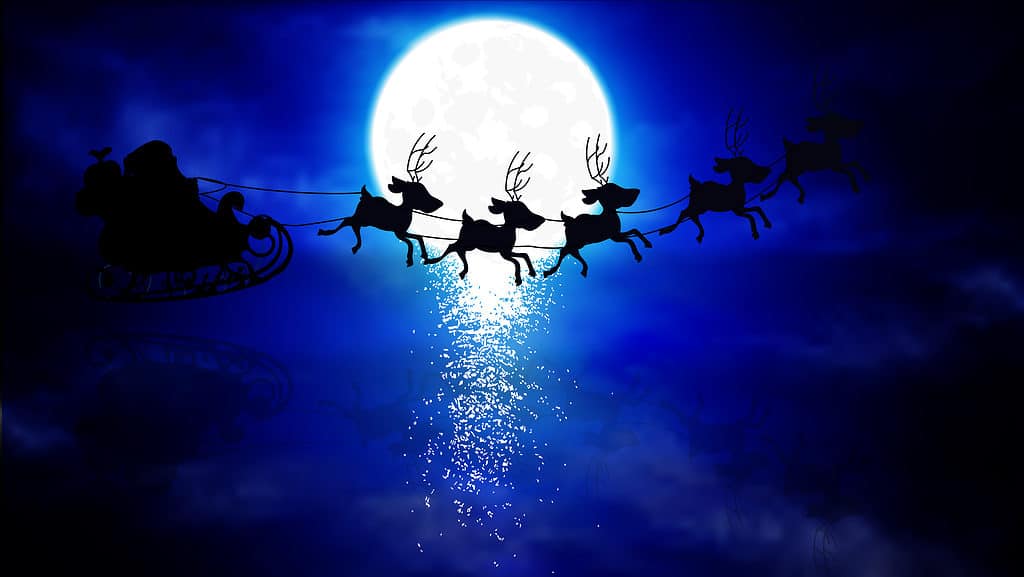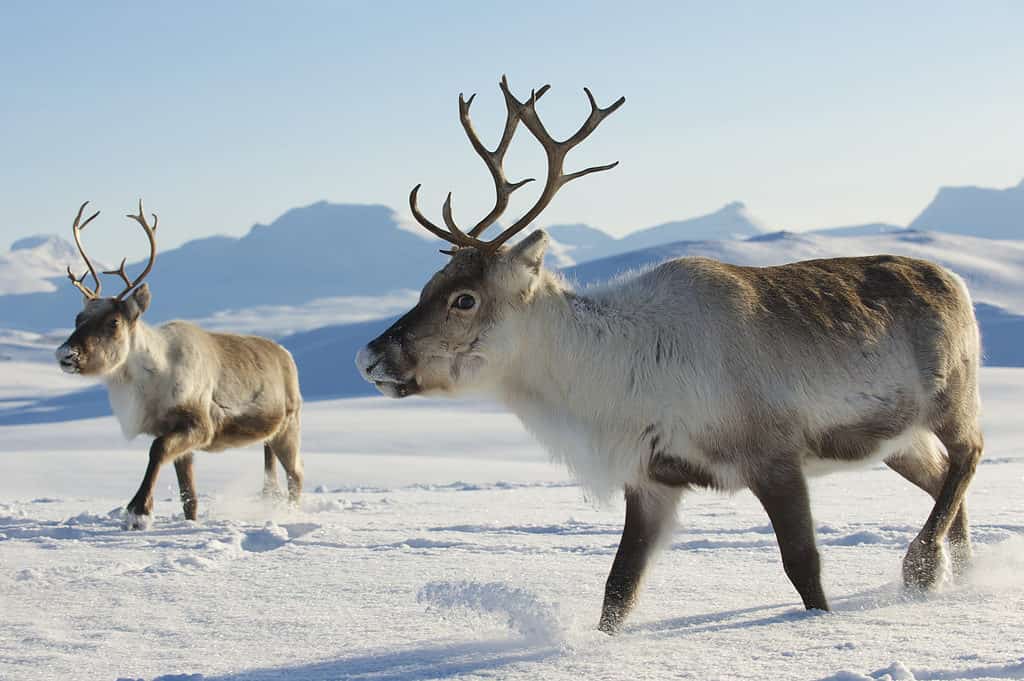Christmas is approaching, and you’ll start seeing images of Santa’s magical reindeer everywhere. You probably already know about Rudolph, the luminous attention-seeker, but can you name the rest? Here we’ll tell you everything about their names and personalities.
How Many Reindeer Does Santa Have?

Media commonly depicts Santa Claus as having either eight or nine reindeer.
©vectorfusionart/Shutterstock.com
In modern times, Santa has nine reindeer.
The first depiction of Santa riding a reindeer-pulled sleigh is from 1821, in the illustrated poem “Old Santeclaus with Much Delight,” which shows just a single deer and doesn’t say its name.
Two years later, the poem “A Visit from St. Nicholas” was printed in New York. It mentions eight reindeer pulling Santa’s sleigh, and popular culture quickly adopted them.
Over a hundred years later, in 1939, the book “Rudolph the Red-Nosed Reindeer” was published. It introduced a new reindeer to the group — the small, timid, red-nosed Rudolph. From then on, these nine reindeer became part of the accepted Christmas lore.
Where Do Their Names Come From?
On December 23, 1823, a newspaper in New York, Sentinel, published the poem “Account of a Visit from St. Nicholas.” It describes Santa Claus as a small, energetic, old man with eight reindeer pulling his sleigh. At one point, Santa says the name of all the reindeer when he orders them to climb up a house so he can enter through the chimney:
More rapid than eagles his coursers they came,
And he whistled, and shouted, and called them by name:
“Now! Dasher, now! Dancer, now! Prancer, and Vixen,
“On! Comet, on! Cupid, on! Dunder and Blixem;
To the top of the porch! To the top of the wall!
Now dash away! Dash away! Dash away all!”
The poem not only installed in popular culture the amount and names of reindeer that accompany Santa, but it also established that he brings the presents on Christmas eve instead of Christmas day. Soon, the text became very famous. It was reprinted in other newspapers, Christmas cards, and other media, sometimes with the title “‘Twas the Night Before Christmas.” From then on, people accepted these eight reindeer as the official Santa Claus helpers.
The original publication has a different name for the last two reindeer, though. They were first named Dunder and Blixem, which is an old Dutch expression that means “thunder and lighting.” In 1837, a new version of the poem was published with several changes, and these two reindeer were renamed Donder and Blixen, probably to improve the rhyming. Finally, in 1844, a collection of poems by Clement Clark Moore included the poem with the title “A Visit from St. Nicholas,” and in this final version, the name of the last two reindeer are Donner and Blitzen, which mean “thunder” and “lightning” in German.
These eight reindeer were the official Santa Claus companions on Christmas Eve for over a century. Then, Rudolph the red-nosed reindeer saw his introduction in 1939. He first appeared in a children’s book published as a Christmas gift by the retail company Montgomery Ward, written in a similar style as Moore’s poem. Its author, Robert L. May, considered many names, like Rollo or Reginald, before deciding upon Rudolph. The story of Rudolph became very successful and was soon adapted into films, songs, and other media. From then on, Rudolph became a relevant part of the Christmas lore, along with the other eight reindeer. Today, he is the best-known of the group.
List of Santa’s Reindeer’s Names and Personalities

A large collection of Christmas and other holiday-themed media have featured Santa’s reindeer.
©CHAPLIA YAROSLAV/Shutterstock.com
Over the years, Santa’s reindeer have been featured in a vast collection of Christmas-themed movies, short stories, songs, poems, and more. In many of them, they’re even the main characters, with Santa relegated to a secondary role. Eventually, they all developed personalities that matched each of their names.
- Dasher — The fastest reindeer. He loves running and is very proud of his speed. He often brags about it, which somewhat annoys the other reindeer.
- Dancer — The most joyful reindeer. She’s very extroverted and loves to make the group laugh and lift their spirits, which she does thanks to her graceful moves.
- Prancer — The most self-centered reindeer. He always proudly shows a clean and shiny coat. But despite his vanity, he’s very affectionate with others.
- Vixen — The reindeer with magic skills. She’s the oldest and wisest of the group but also a bit of a trickster.
- Comet — The most handsome reindeer. He’s very good with kids and loves delivering them gifts. He also has a great intellect and likes looking at the stars.
- Cupid — The most loving reindeer. He’s extremely affectionate and loves to talk to the rest, even when they’re doing hard work, which sometimes is a bit exhausting.
- Donner — The singing reindeer. His name means thunder, which perfectly fits his beautiful and powerful voice, and he loves to sing.
- Blitzen — The playful and busy reindeer. He’s very responsible and leads by example, but he also loves to play and is a bit jumpy. He’s the one who helps Santa when he gets stuck in chimneys.
- Rudolph — The red-nosed reindeer. He lights up the path for Santa’s sleigh during the flight. The other reindeer picked on him because of his nose and small size but found his true worth as the guiding light of Santa’s sleigh.
Are Santa’s Reindeer Male or Female?

Male and female reindeer both have
antlers
. Male reindeer, though, lose their antlers during winter and regrow them in spring.
©Dmitry Chulov/Shutterstock.com
Both male and female reindeer have antlers, unlike other members of the Cervidae family. However, the males lose the horns during the winter and regrow them in spring, while females keep their antlers all through the winter and usually lose them in the spring after giving birth.
Based on most of the representations of Santa’s reindeer, we should conclude they’re all female, as we can see they all have their antlers by late December. However, this may also be because Denver Gillen, who illustrated the original “Rudolph the Red-Nosed Reindeer” edition, used zoo deer as models.
As of today, many people consider Santa’s reindeer to be female. This is not only because of their antlers, but also because female reindeer are better equipped to travel in arctic regions, thanks to their higher body fat percentage. However, in popular culture, you’ll find them represented mainly as a group of males, with just one or two females.
Up Next…
- 12 Incredible Reindeer Facts for Christmas
- Christmas Reindeer: What’s the Story Behind Santa and Reindeer?
- Discover the Largest Christmas Tree Ever
The photo featured at the top of this post is © retrorocket/Shutterstock.com
Sources
- Poetry Foundation, Available here: https://www.poetryfoundation.org/poems/43171/a-visit-from-st-nicholas
- Yes Santa is Real, Available here: https://yessantaisreal.com/what-are-the-names-of-santas-reindeer/
- Snopes, Available here: https://www.snopes.com/fact-check/the-donner-partys-over/
- Love to Know, Available here: https://christmas.lovetoknow.com/about-christmas/list-santas-reindeer-names
- Live Science, Available here: https://www.livescience.com/32149-are-santas-reindeer-males.html
Thank you for reading! Have some feedback for us? Contact the AZ Animals editorial team.






